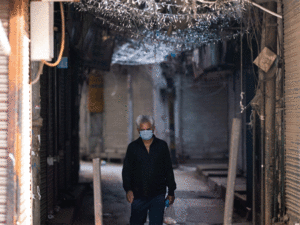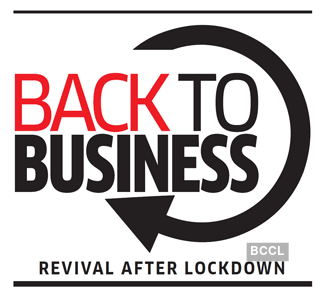View: India needs a set of fiscal measures, and granular back-to-work protocols, to save both lives and livelihoods

Given that India’s fiscal resources are constrained, RBI may need to finance some portion of this incremental government spending.

COVID-19 CASES
WorldIndiaConfirmed6,761Deaths206Confirmed1,595,350Deaths95,455By Anu Madgavkar & Rajat Gupta
The Covid-19 pandemic is the greatest health and humanitarian challenge the world has faced since World War 2. In response, India has moved quickly to implement a nationwide, 21-day lockdown, with a view to flattening the curve and using the time to consolidate its healthcare resources.
Along with its unprecedented human toll, the pandemic has triggered a deep economic crisis. The global growth outlook is bleak. If the virus were contained by the current lockdown, India’s GDP may grow 1-2% in FY2021. But if it needs to be extended until mid-May in its current form, with a gradual restarting of supply chains, India’s GDP in Q1 FY2021 could contract by 20%, and by 2-3% in FY2021. In the event of more national lockdowns, it could contract by as much as 8-10% for FY2021.
Assuming Scenario 2 plays out, the livelihoods of 32 million workers, including many in the informal workforce, could be affected. High credit strain would be seen in travel, transport and logistics, textiles, power and the hotel and entertainment sectors, and for MSMEs across the board.

With widespread MSME and corporate financial stress, non-performing loans (NPLs) in the financial system could rise by 7 percentage points of loans. The financial system could face both solvency and liquidity risk, as payments freeze in the corporate and SME supply chains, and workers are laid off. If this triggers risk aversion or even loss of depositor confidence, it will be difficult to recover from.
Given the magnitude of potential unemployment, business failure and risk for the financial system, a comprehensive package of fiscal and monetary interventions needs to be planned, keeping Scenario 2 in mind, to be triggered progressively and executed rapidly as the situation evolves. Such a credible, system-wide stabilisation package could exceed Rs10 lakh crore, or more than 5% of GDP.
Broad themes for consideration could include GoI paying part of the payroll of the 60 million informal workers linked to companies and providing direct income support for the 135 million that are not. For bankruptcy protection and liquidity support, MSMEs could receive liquidity lines from their banks, refinanced by RBI, with substantial credit backstops from the government, contingent on these companies protecting their employees. Existing credit guarantee funds could be expanded with GoI absorbing a major portion of the costs of likely new NPLs.
For large corporates, banks could be allowed to restructure the debt on their balance sheets, and procedural requirements relaxed for raising capital. In select distressed sectors (travel, logistics, auto, textiles, construction, power, etc), GoI could infuse capital through a temporary TARP (troubled asset relief program)-type program.
Again, appropriate conditions would need to be imposed to safeguard workers and MSMEs and make the process transparent. Some banks/non-banks may require measures to strengthen their capital and liquidity, along with measures to step up liquidity in corporate bond and government securities markets.
To manage the macro-economic consequences of a fiscal package of this order of magnitude, it should be clearly communicated that these measures are deep, but temporary. Some support may be structured as contingent liabilities that only get reflected in the fiscal deficit when they devolve.
Given that India’s fiscal resources are constrained, RBI may need to finance some portion of this incremental government spending. The inflationary effects may be low as lockdowns severely constrict demand, but price increases could occur in sectors like food so appropriate steps are needed to maintain supply chains.
Beyond stimulus measures, the pace and pattern of lifting lockdowns will be crucial. How it unfolds in India will depend on the availability of crucial testing capabilities, granular data and technology to track and trace infections and the healthcare facilities to treat patients.
Protocols, co-created with industry, will be needed for different settings (mandis, factories, BPOs, etc). Industrial areas like Vapi and Baddi could be ring-fenced for safety, with local dormitories set up for the labour and minimal movement in and out of the site allowed. While the principles may be the same for construction sites and BPOs, the specifics would differ.
A geographic lens could be overlaid to determine how quickly the lockdown could be lifted with the new protocols in place. Red, yellow and green zones could be created – as they have been in Malaysia, Indonesia and Thailand – with unambiguous criteria and clear rules for activity laid down. The definition of a ‘zone’ would need to be granular — ward, colony, or building cluster — to allow as much economic activity as safely possible, while targeting infection as accurately as possible. Since there is a very real possibility of the virus lingering on through the year, this micro-targeting approach could help decelerate its spread while keeping livelihoods going.
Specific actions could be tailored to different districts, depending on population density, the relative strength of their healthcare systems, and the scale of infection locally. India could gear up for local execution by equipping 700-plus high-performing government officers, and from cities like Mumbai and states like Kerala that are today fighting the pandemic.
These officers could be deputed to work with the district magistrates, dynamically developing and executing locally tailored lockdowns, healthcare expansion efforts and back-to-work protocols, supported by cross-functional centres of excellence at state and/or Centre.
Both lives and livelihoods must be preserved in this crisis. India must consider a set of fiscal measures, and granular back-to-work protocols, to make it happen.
Madgavkar and Gupta are partner, McKinsey Global Institute (MGI), and senior partner, McKinsey & Company, respectively
Source: indiatimes.com

